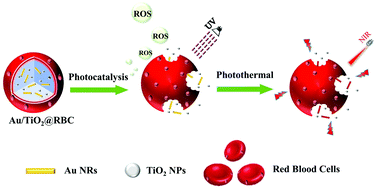Erythrocyte membrane nano-capsules: biomimetic delivery and controlled release of photothermal–photochemical coupling agents for cancer cell therapy†
Abstract
Photothermal therapy (PTT), which involves an increase in temperature triggered only by light signals at tumor sites to remove cancer cells, has been considered an attractive strategy in cancer therapy. Nevertheless, the in vivo applications of photosensitizer-based PTT are limited due to the poor biocompatibility of photothermal agents. Employing red blood cell (RBC) membranes to encapsulate photothermal agents can solve this issue, but the extra surface coating will suppress heat dissipation, which is unfavorable for the subsequent treatment. Herein, biomimetic nano-capsules have been fabricated for light signal-activated cancer therapy by encapsulating photocatalyst titanium dioxide colloid and photothermal agent gold nanorods (Au NRs) in erythrocyte membrane vesicles. The fabricated Au/TiO2@RBC nano-capsules can achieve the controlled release of Au NRs upon the photocatalytic degradation of their surface cell membrane coatings, and generate therapeutic signals after the released Au NRs are irradiated by an NIR laser. Meanwhile, the reactive oxygen species (ROS) produced by photocatalysis are helpful for killing tumor cells photodynamically. Thus, the biomimetic nano-capsules prepared herein will contribute to the research and development in cancer cell therapy.



 Please wait while we load your content...
Please wait while we load your content...